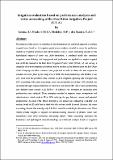Por favor, use este identificador para citar o enlazar a este item:
http://hdl.handle.net/10261/39060COMPARTIR / EXPORTAR:
 SHARE SHARE
 CORE
BASE CORE
BASE
|
|
| Visualizar otros formatos: MARC | Dublin Core | RDF | ORE | MODS | METS | DIDL | DATACITE | |

| Título: | Irrigation evaluation based on performance analysis and water accounting at the Bear River Irrigation Project (U.S.A.) |
Autor: | Lecina Brau, Sergio CSIC; Neale, C. M. U.; Merkley, G. P.; dos Santos, C. A. C. | Palabras clave: | land productivity surface irrigation water accounting water balance, water consumption water depletion Water management water productivity |
Fecha de publicación: | jul-2011 | Editor: | Elsevier | Citación: | Lecina S, Neale CMU, Merkeley GP, dos Santos CAC. Irrigation evaluation based on performance analysis and water accounting at the Bear River Irrigation Project (U.S.A.). Agricultural water management 98 (9): 349-1363 (2011) | Resumen: | The purpose of this work is to contribute to the development of a combined approach to evaluate irrigated areas based on: (1) irrigation performance analysis intended to assess the productive impacts of irrigation practices and infrastructures, and (2) water accounting focused on the hydrological impacts of water use. Ador-Simulation, a combined model that simulates irrigation, water delivery, and crop growth and production was applied in a surface irrigated area (1213 ha) located in the Bear River Irrigation Project, Utah, U.S.A.. A soil survey, a campaign of on-farm irrigation evaluations and an analysis of the database from the Bear River Canal Company and other resources were performed in order to obtain the data required to simulate the water flows of the study area in 2008. Net land productivity (581 US$ ha−1) was 20% lower than the potential value, whereas on-farm irrigation efficiency (IE) averaged only 60%. According to the water accounting, water use amounted to 14.24 Mm3, 86% of which was consumed through evapotranspiration or otherwise non-recoverable. Gross water productivity over depleted water reached 0.132 US$ m−3. In addition, two strategies for increasing farm productivity were analyzed. These strategies intended to improve water management and infrastructures raised on-farm IE to 90% reducing the gap between current and potential productivities by about 50%. Water diverted to the project was reduced by 2.64 Mm3. An analysis based on IE could lead to think that this volume would be saved. However, the water accounting showed that actually only 0.91 Mm3 would be available for alternative uses. These results provide insights to support the decision-making processes of farmers, water user associations, river basin authorities and policy makers. Water accounting overcomes the limitations and hydrological misunderstandings of traditional analysis based on irrigation efficiency to assess irrigated areas in the context of water scarcity and competitive agricultural markets. | Descripción: | The definitive version is available at: http://www.elsevier.com/locate/agwat | Versión del editor: | http://dx.doi.org/10.1016/j.agwat.2011.04.001 | URI: | http://hdl.handle.net/10261/39060 | DOI: | 10.1016/j.agwat.2011.04.001 | ISSN: | 0378-3774 |
| Aparece en las colecciones: | (EEAD) Artículos |
Ficheros en este ítem:
| Fichero | Descripción | Tamaño | Formato | |
|---|---|---|---|---|
| LecinaS_AgrWatMan_2011.pdf | 317,18 kB | Adobe PDF |  Visualizar/Abrir |
CORE Recommender
SCOPUSTM
Citations
18
checked on 08-abr-2024
WEB OF SCIENCETM
Citations
16
checked on 25-feb-2024
Page view(s)
336
checked on 16-abr-2024
Download(s)
350
checked on 16-abr-2024
Google ScholarTM
Check
Altmetric
Altmetric
NOTA: Los ítems de Digital.CSIC están protegidos por copyright, con todos los derechos reservados, a menos que se indique lo contrario.
